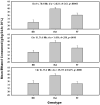A method for mapping intralocus interactions influencing excessive alcohol drinking
- PMID: 20033183
- PMCID: PMC2850100
- DOI: 10.1007/s00335-009-9239-9
A method for mapping intralocus interactions influencing excessive alcohol drinking
Abstract
Excessive alcohol (ethanol) consumption is the hallmark of alcohol use disorders. The F1 hybrid cross between the C57BL/6J (B6) and FVB/NJ (FVB) inbred mouse strains consumes more ethanol than either progenitor strain. The purpose of this study was to utilize ethanol-drinking data and genetic information to map genes that result in overdominant (or heterotic) ethanol drinking. About 600 B6 x FVB F2 mice, half of each sex, were tested for ethanol intake and preference in a 24-h, two-bottle water versus ethanol choice procedure, with ascending ethanol concentrations. They were then tested for ethanol intake in a Drinking in the Dark (DID) procedure, first when there was no water choice and then when ethanol was offered versus water. DNA samples were obtained and genome-wide QTL analyses were performed to search for single QTLs (both additive and dominance effects) and interactions between pairs of QTLs, or epistasis. On average, F2 mice consumed excessive amounts of ethanol in the 24-h choice procedure, consistent with high levels of consumption seen in the F1 cross. Consumption in the DID procedure was similar or higher than amounts reported previously for the B6 progenitor. QTLs resulting in heightened consumption in heterozygous compared to homozygous animals were found on Chrs 11, 15, and 16 for 24-h choice 30% ethanol consumption, and on Chr 11 for DID. No evidence was found for epistasis between any pair of significant or suggestive QTLs. This indicates that the hybrid overdominance is due to intralocus interactions at the level of individual QTL.
Figures









Similar articles
-
Hybrid mice as genetic models of high alcohol consumption.Behav Genet. 2010 Jan;40(1):93-110. doi: 10.1007/s10519-009-9298-4. Epub 2009 Oct 2. Behav Genet. 2010. PMID: 19798565 Free PMC article.
-
Voluntary ethanol consumption by mice: genome-wide analysis of quantitative trait loci and their interactions in a C57BL/6ByJ x 129P3/J F2 intercross.Genome Res. 2002 Aug;12(8):1257-68. doi: 10.1101/gr.129702. Genome Res. 2002. PMID: 12176933 Free PMC article.
-
Mapping of QTLs for oral alcohol self-administration in B6.C and B6.I quasi-congenic RQI strains.Neurochem Res. 2007 Jul;32(7):1099-112. doi: 10.1007/s11064-006-9234-4. Epub 2007 Feb 2. Neurochem Res. 2007. PMID: 17273929 Free PMC article.
-
Strategies for mapping and identifying quantitative trait loci specifying behavioral responses to alcohol.Alcohol Clin Exp Res. 1995 Aug;19(4):795-801. doi: 10.1111/j.1530-0277.1995.tb00949.x. Alcohol Clin Exp Res. 1995. PMID: 7485822 Review.
-
Identifying genes for alcohol and drug sensitivity: recent progress and future directions.Trends Neurosci. 1999 Apr;22(4):173-9. doi: 10.1016/s0166-2236(99)01393-4. Trends Neurosci. 1999. PMID: 10203855 Review.
Cited by
-
Epigenetics and biomarkers in the staging of neuropsychiatric disorders.Neurotox Res. 2010 Nov;18(3-4):347-66. doi: 10.1007/s12640-010-9163-5. Epub 2010 Mar 17. Neurotox Res. 2010. PMID: 20237880 Review.
-
DISCOVERY AND VALIDATION OF GENES DRIVING DRUG-INTAKE AND RELATED BEHAVIORAL TRAITS IN MICE.bioRxiv [Preprint]. 2023 Jul 10:2023.07.09.548280. doi: 10.1101/2023.07.09.548280. bioRxiv. 2023. Update in: Genes Brain Behav. 2024 Jan 2:e12875. doi: 10.1111/gbb.12875. PMID: 37503148 Free PMC article. Updated. Preprint.
-
Oral Nicotine Self-Administration in Rodents.J Addict Res Ther. 2012 Jun 1;S2:004. doi: 10.4172/2155-6105.S2-004. J Addict Res Ther. 2012. PMID: 23264883 Free PMC article.
-
Neuropeptide Y response to alcohol is altered in nucleus accumbens of mice selectively bred for drinking to intoxication.Behav Brain Res. 2016 Apr 1;302:160-70. doi: 10.1016/j.bbr.2016.01.015. Epub 2016 Jan 9. Behav Brain Res. 2016. PMID: 26779672 Free PMC article.
-
A systems genetic analysis of alcohol drinking by mice, rats and men: influence of brain GABAergic transmission.Neuropharmacology. 2011 Jun;60(7-8):1269-80. doi: 10.1016/j.neuropharm.2010.12.019. Epub 2010 Dec 23. Neuropharmacology. 2011. PMID: 21185315 Free PMC article.
References
-
- Belknap JK, Atkins AL. The replicability of QTLs for murine alcohol preference drinking behavior across eight independent studies. Mamm Genome. 2001;12:893–899. - PubMed
-
- Belknap JK, Crabbe JC, Young ER. Voluntary consumption of ethanol in 15 inbred mouse strains. Psychopharmacology. 1993;112:503–510. - PubMed
-
- Bergeson SE, Kyle Warren R, Crabbe JC, Metten P, Erwin VG, Belknap JK. Chromosomal loci influencing chronic alcohol withdrawal severity. Mamm Genome. 2003;14:454–463. - PubMed
-
- Boehm SL, II, Schafer GL, Phillips TJ, Browman KE, Crabbe JC. Sensitivity to ethanol-induced motor incoordination in 5-HT(1B) receptor null mutant mice is task-dependent: implications for behavioral assessment of genetically altered mice. Behav Neurosci. 2000;114:401–409. - PubMed
Publication types
MeSH terms
Grants and funding
LinkOut - more resources
Full Text Sources
Medical
Molecular Biology Databases
Miscellaneous

